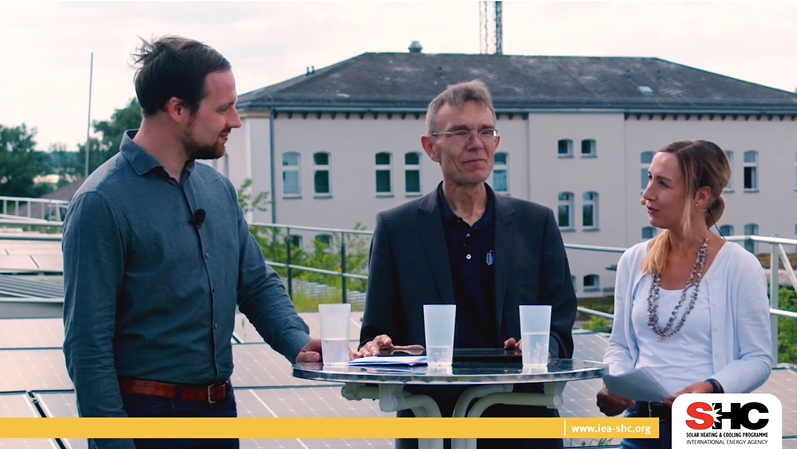
Buildings with a high solar fraction require a good mix of technologies and energy efficiency measures. The scientists of IEA SHC Task 66 on Solar Energy Buildings have analysed 150 such buildings and identified and listed the new and innovative elements. The Technology Radar for Solar Energy Buildings contains over 50 measures that have been assessed in terms of their market availability and market potential. Michael Gumhalter from the Austrian institute AEE INTEC led this work (on the left in the picture). The most promising technologies will also be described in factsheets put together in the report New Technologies and Components for Solar Energy Buildings, which will be published at the beginning of 2025. The photo originates from a film describing the major results of Task 66, which ended in September 2024.
“I am very satisfied with the results of the work carried out by Michael Gumhalter and his team. They conducted a profound technical and application-related assessment of new and innovative technologies and components that contribute to achieving the goal of solar energy buildings”, said Harald Drück, Manager of IEA SHC Task 66. The Technology Radar groups all measures into the following four areas: generation, storage, thermal grids and building & community. “We have rated more than 50 technologies and solutions in terms of their relevance in solar energy buildings until 2026”, explained Gumhalter. “We checked facts such as technology readiness level but also made a qualitative assessment based on the high level of expertise and experience available in the multi-institutional Task 66 team.”
The researchers discussed and rated the following questions for all solutions:
Are there any barriers that hinder current and future market entry?
Are there national and international regulations that support or hinder a specific solution?
Is a technology strong enough to compete in the market with its advantages and cost?
How strong is the total value of the solution for building projects and hence its potential growth rate?
Technology Radar for Solar Energy Buildings featuring technology and components that contribute to achieving the aims of solar energy buildings Source: Task 66
According to this intensive assessment, 24 measures are highlighted in green in the Technology Radar, with high market relevance. In addition to the most common ones such as PV, solar thermal, biomass boilers and various types of heat pump, innovative solutions such as covered and uncovered PVT collectors, thermal building mass activation, ice storage and low-temperature district heating grids are also included.
The Task 66 team wanted to make the results of the intensive assessment of innovative and solar-energy-related measures accessible to all relevant stakeholders such as architects and practitioners. They have therefore gathered multi-page factsheets for selected technologies, which will be summarized in the report New Technologies and Components for Solar Energy Buildings, to be published in early 2025 here. The fact sheets typically include a description of the technology, notes on effective integration into building services or building envelopes, examples of use and an evaluation of their contribution to solar energy buildings.
Example: An evacuated tube air collector can support solar energy buildings in a variety of ways. The contribution is specified in detail in each factsheet. Source: Task 66
Fact sheets feature established and innovative measures
The focus in the Generation chapter is on PVT and innovative solar-air collectors. Here, four company representatives present their products:
Evacuated tube air collector from Airwasol, Germany
Brine-air heat pump collector from Consolar, Germany
Hybrid vacuum-tube PVT from Naked Energy, Great Britain
An overview of air-based PVT solutions drafted by Sunovate, USA
Most of the factsheets are in the Storage chapter. Among other things, concepts already in commercial use are described here, such as rock-bed storage, with examples of buildings in India and Argentina, and ice storage systems in use in Germany. The fact sheet on thermal storage with vacuum insulation describes the two approaches available on the market today: bendable vacuum insulation panels and double-walled hot water storage tanks. However, concepts for large storage facilities e.g. in mines, earth basins or boreholes are also analysed more closely.
Architects will certainly find interesting suggestions on the fact sheets in the Building & Communities chapter. For example façade-integrated mini-split heat pumps for decentralized hot water production or thermo-regulative nanofluid façades are presented here with the latter being in the laboratory stages. Another factsheet describes how Model Predictive Control works. Here a mathematical model predicts the future behaviour of the building’s temperature and energy consumption typically ranging from minutes to hours. It analyses different control strategies to meet desired setpoints, such as maintaining comfort levels while minimizing energy use.
Model Predictive Control (MPC) is an advanced control strategy to enhance energy efficiency in buildings Source: Task 66
Finally, we quote an important comment from the team of authors of the soon-to-be-published report with the fact sheets: “While the collected information is effective in summarizing key points, the ultimate decision on adopting a technology should be supported by practical demonstrations and collaborations with research institutions, as paper-based assessments alone may not fully capture the complexities and real-world performance of solar energy systems.”